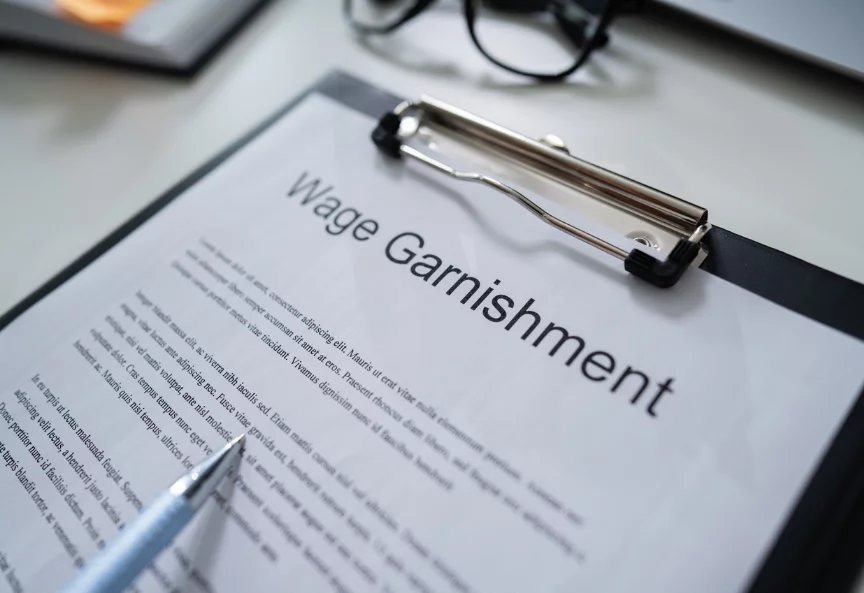Receiving mail from the IRS is seldom a pleasant experience, excepting the occasional tax refund. It’s even less enjoyable when the message comes with a bill, or worse. While the IRS faces a significant tax gap each year, they mobilize its resources to close that gap, including issuing tax liens and levies to encourage or coerce repayment. The IRS may begin levying your wages when it finds no alternative to recoup your tax liability. This is called wage garnishment.
What Is Wage Garnishment?
Wage garnishment occurs when a creditor moves to claim a portion of your paycheck from your employer for an unpaid debt. In the case of the IRS, the government is garnishing your wages for outstanding tax debt. However, the IRS does not just start garnishing your wages out of the blue.
When Does the IRS Garnish Wages?
There is a process in place before wage garnishment can begin, beginning with the tax assessment. If you send in a tax return and the IRS figures that you owe more than you’ve paid thus far, or if you’ve accrued an unpaid penalty, the IRS will send you a notice of your due taxes and outstanding tax liability, with the order to pay your debt immediately. The longer you wait, the more your debt grows through failure to pay penalties and accrued interest.
At this point, the IRS may wait for your debt to reach a specific limit before filing a Notice of a Federal Tax Lien. The government may turn to levies and garnishment if the lien does not apply enough pressure. Failure to contact them and negotiate a payment plan or pay off your debt may lead to a Final Notice of Intent to Levy. This is often the last step before the IRS thinks about wage garnishment.
At this point, the IRS will mail Publication 1494 to your employer, instructing them on exempting a certain amount of wages from the levy. Your employer will require you to fill out the information about your filing status and dependents, which you have three days to provide. Otherwise, your employer will only be able to deduct the standard amount from the wage levy. The lower your income and the more dependents you have, the higher the chance that the IRS cannot levy your wages, to begin with. Otherwise, a minimum exemption is calculated, and the rest is skimmed off to pay your debt incrementally. Your debt will continue to accrue interest in the process.
At every step throughout this process, you as a taxpayer have the right to a collection due process hearing to appeal your situation. However, you need solid evidence to suggest that the IRS is wrong or that you genuinely do not owe that initial tax debt. Do not consider filing for an appeal without first consulting a tax attorney. If an appeal is off the table, your next steps are limited. Once the IRS provides you with your final notice, you have 30 days from the date the notice was issued before your wages are garnished.
Wage Garnishment vs. IRS Levies
There are generally three levies: wage levies, asset levies, and bank levies. This means the IRS can either wipe out a bank account, claim an asset such as a vehicle, piece of real estate, or other personal property, or claim a portion of every paycheck you earn. Wage levies are continuous. In the case of a bank levy or an asset levy, the IRS takes one target asset or seizes one account and empties it before issuing a notice of another levy.
Once the debt is satisfied, the remainder is sent back to you. If the IRS seizes an asset, such as a vehicle or a piece of land, it will liquidate that asset at its quick salve value rather than peak market price. This speeds up the process and increases the likelihood of finding a buyer at relatively short notice. When the IRS seizes your wages or claims money from your bank account, there isn’t much you can do to reverse that.
However, when the IRS claims the property, there is a grace period wherein you can try to resolve your debt or stop the garnishment before the IRS liquidates your assets. Certain assets are effectively exempt from seizure – for example, the IRS isn’t going to claim the only roof above your head or the only car you own to get to and from work unless you have taken an incredibly standoffish position.
In general, the IRS claims to work with taxpayers – and if the IRS is purposefully driving you towards financial ruin, you can contact a tax attorney to help you argue financial hardship. Regardless of whether your wages are being seized or the IRS is having your cars claimed, it would be best if you acted the moment you receive that final notice.
Stopping Wage Garnishment
There are three ways to stop a wage garnishment:
- Pay off your debt.
- Enter into a payment agreement and make significant contributions towards eliminating your debt.
- File as currently not collectible.
While limited, these are ultimately your best options. Bankruptcy is another, but bankruptcy does not always wipe out tax debts. It may be better for you to try and claim financial hardship to work your way out of trouble without taking the hit to your credit that bankruptcy lands.
What If I Can’t Pay?
The IRS accepts multiple payment plans, each with its prerequisite pros and cons. You don’t have to tackle your entire tax debt in a single payment. However, most IRS payment plans can be broken down into short-term payment plans (less than six months) and long-term payment plans (more than six months). The limit for an IRS payment plan is usually either five years or the end of your debt’s statute of limitations, whichever comes first.
Based on this and your total debt, you can work out your monthly payments to the IRS (including interest) and keep the IRS from continuing to garnish your wages or claim your property. The IRS may also rescind the federal tax lien on your property if you make at least three consecutive payments with no prior history of defaulting, offenses, or penalties in the last three years. However, what if you can’t pay? There are still other options.
Offers in Compromise
The IRS will periodically check in to determine whether your finances have improved enough to warrant a payment plan before resuming collection actions, such as liens and levies. If you are under financial distress, then you may be able to argue that your tax account is currently not collectible. Under these circumstances, the IRS will stop hounding you, but your tax debt will continue to grow.
But if you still have some wiggle room financially, you may be able to file for an offer in compromise. An offer in compromise requires you to file a Form 656, alongside Form 433-A, a unique Collection Information Statement laying your finances bare. You must formulate the offer yourself (with the help of an attorney). Your request will be rejected if it does not match the IRS’s reasonable collection potential calculated from your financial details.
A tax professional’s help can minimize the chances of rejection. Wage garnishment can be difficult to stop. If you are about to be levied by the government, get professional tax help. While the IRS offers ample time to negotiate, it might not always be enough.

